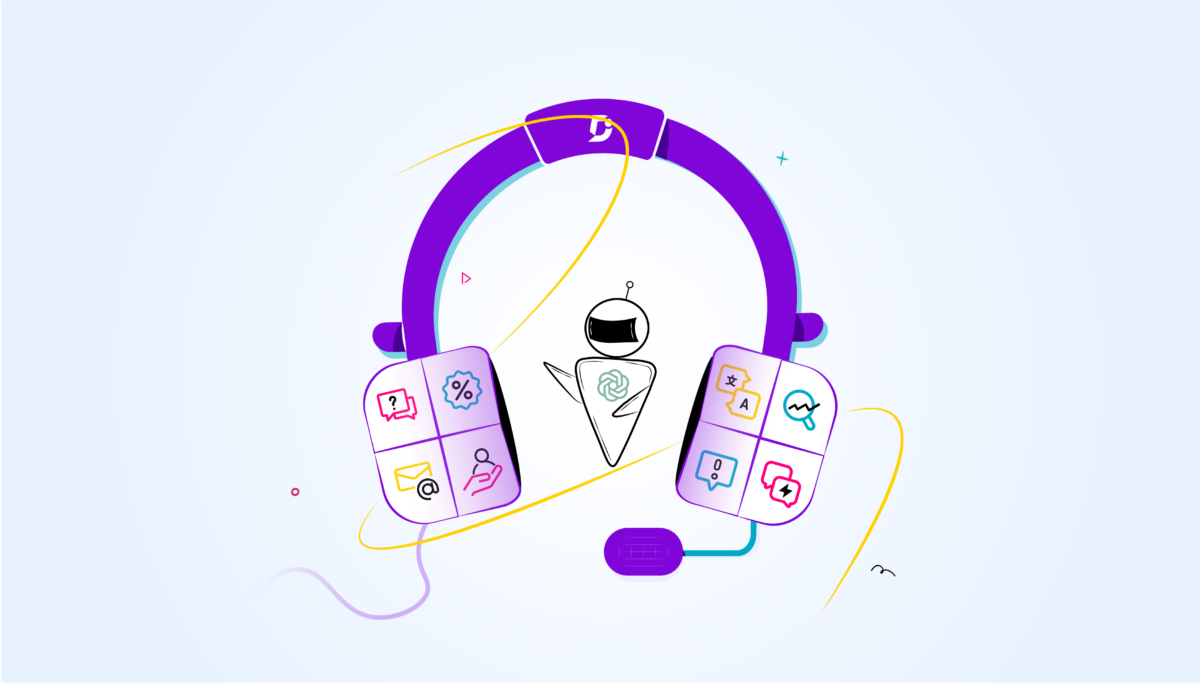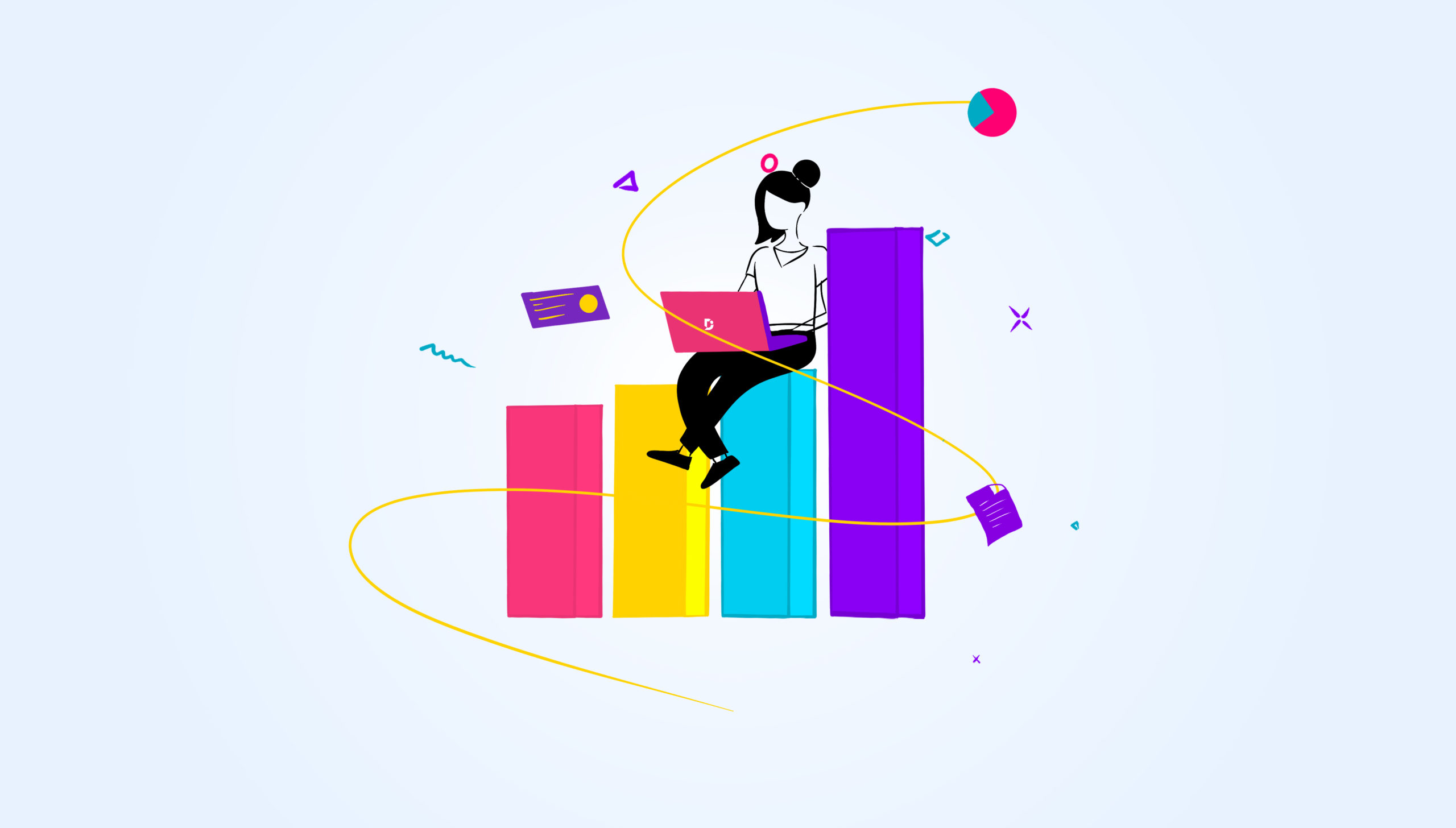The use of generative AI is here to stay, as it has begun to gain widespread acceptance and attention across various industries in the last decade. With the introduction of ChatGPT, the most popular generative AI tool, we can transform how information is accessed.
What is Knowledge Management?
No organization can survive without the distribution or dissemination of knowledge. This makes knowledge management a crucial part of any company’s existence. It refers to structuring, recollecting, and sharing knowledge within an organization. This is possible because companies accumulate significant knowledge as they evolve and expand their business operations.
Therefore, rather than subject employees to rigid processes where they spend significant time on issues that have been solved previously, this knowledge can be put together in an accessible form to help new or less experienced employees integrate into the organization’s operations successfully. Knowledge management is about improving business efficiency through an efficient cycle of creating and sharing knowledge that can build a more effective workforce.
What is ChatGPT?
In November 2022, there was a lot of buzz online as OpenAI introduced the latest advancement in AI technology, ChatGPT, a tool that provides human-like answers in a chat format. Specifically, ChatGPT is a natural language processing tool that uses AI technology to drive human-like conversations with a chatbot. You can ask ChatGPT to write almost anything through this language model, including essays, emails, blog posts, and even computer codes.
ChatGPT can serve as a comprehensive database of knowledge that can be accessed with the right prompt. Knowing this has piqued my curiosity about the role of ChatGPT in knowledge management. This AI tool impacts knowledge management as it can help retrieve valuable knowledge within an organization. A vast AI technology like this can make assessing extensive databases and knowledge bases easier and less time-consuming.
Benefits of Using ChatGPT in Knowledge Management
Generative AI in knowledge management can become a reality in the 21st century as it offers numerous benefits that organizations can tap into. Let’s take a look at some of the benefits.
Improved Information Access
ChatGPT can be integrated into compatible knowledge management systems to help employees access information faster and easier. This tool has AI-powered capabilities that efficiently retrieve information, resources, and documents, which is essential to successful knowledge management. With this, users don’t have to search manually for papers to solve problems, especially during emergency scenarios.
Ultimately, this gives employees access to up-to-date information with just a few prompts and saves valuable time, which increases their productivity.
Enhanced Knowledge Sharing and Collaboration
Another benefit of ChatGPT is that it encourages enhanced knowledge sharing and collaboration where employees can work together seamlessly. One of the barriers to growth in an organization is a knowledge gap between employees, where experienced workforce members cannot quickly transfer their knowledge to new or transferred employees. This eventually leads to the company spending more resources to train employees.
However, ChatGPT works as an interactive platform where employees can gain valuable insights by asking questions and exchanging ideas with the AI platform, so it receives the new information and adjusts accordingly. Doing this encourages a continuous learning and collaboration environment where there is no limit to knowledge transfer across various departments within an organization.
Increased Employee Experience
The impact of ChatGPT can also be felt through improvements in overall employee experiences. Knowledge management within an organization is successful when employees can access knowledge promptly without moving through numerous hurdles. However, when employees spend extra effort to gain access to critical information, this leads to a drop in positive experiences in the workplace.
ChatGPT mitigates this by providing a user-friendly interface that is super easy to activate through a chatbot. Rather than navigate complex databases or search through massive repositories, employees can use a few prompts to access resources and information at their fingertips.
Self-Service Support
Another considerable benefit of a well-trained ChatGPT is the self-service support it provides to employees. This reduces customers’ information barriers and provides handy solutions to issues without a support staff.
Typically, organizations would have to set up a dedicated support team to attend to employee queries, increasing the company’s running costs. However, ChatGPT eliminates this need by providing a self-service knowledge base that helps organizations optimize resources, reduce response times, and scale their support capabilities.
Also, Check out our article on ChatGPT and the Future of Customer FAQs: Trends and Predictions
Real-Time Knowledge Retrieval
Incorporating generative AI knowledge management is excellent for real-time knowledge retrieval. Sometimes, the difference between fixing an issue promptly and letting it degenerate into a full-blown organizational crisis is the time it takes to retrieve the knowledge on how to solve the problem. ChatGPT offers an instant knowledge retrieval feature that saves valuable time.
With this AI tool in knowledge management, users can quickly analyze queries, find the necessary information without spending more time searching vast knowledge bases, and use a prompt to generate accurate responses within a few minutes. With real-time knowledge retrieval accessible through ChatGPT, employees can improve their problem-solving skills and enjoy speedy decision-making processes.
Implementing ChatGPT in Knowledge Management
What’s the best way to implement ChatGPT in knowledge management? We propose a 4-step comprehensive process that starts with assessing your knowledge assets and ultimately developing a content policy for original content generation.
Assessing Your Knowledge Assets
To successfully implement ChatGPT in knowledge management, you must assess your knowledge assets to be fully aware of the information and resources within your grasp. Identify and categorize these knowledge assets, including FAQs, manuals, reports, how-to articles, and other documents relevant to your company’s database.
These should be categorized based on their purpose, as some could function as internal policies while others are more relevant for technical knowledge. This categorization gives you a clear understanding of the extent of your database and how much information is available for knowledge sharing. However, not all will be useful.
This is why they should be appropriately assessed to determine their quality. Are there redundant data points? Have more up-to-date trends in your industry replaced them? These knowledge gaps should be identified, with an emphasis on checking the credibility of the contributors to these materials.
You should also assess how easy it is for employees to retrieve these knowledge assets. Are your knowledge management processes efficient and user-friendly? This will reveal employees’ challenges when searching for valuable resources to solve diverse problems. Assessing your knowledge assets makes it easy to identify areas where ChatGPT can help with knowledge retrieval. This is the foundation for creating a working knowledge management strategy.
Building a Knowledge Base for Your Organization
Another critical step in implementing ChatGPT in knowledge management is to set up a well-structured and comprehensive knowledge base for your organization. This will serve as a central source of information that employees can easily use. Start this process by organizing the data within the knowledge base properly.
The goal is to categorize them based on relevance and purpose, using whatever structure allows users to navigate the knowledge base efficiently. Be sure to select the appropriate format for presenting each data. This could range from PDFs for policy documents to how-to guides for instruction manuals. It’s essential to keep them accurate and consistent, as up-to-date information is required to reflect the latest policies for your company.
Meanwhile, this effort is only fruitful if the search functionality is robust enough to encourage accuracy during searches or make content discovery seamless. Use intuitive navigation features to help employees find the information they need quickly. Every day, industries evolve, and your knowledge base needs regular maintenance and review to eliminate knowledge gaps.
Integrating ChatGPT into Your Existing Platforms
This process allows you to leverage the capabilities of ChatGPT for knowledge management while ensuring that it works seamlessly with other platforms familiar to employees within your organization. This is great for employees using familiar interfaces to access knowledge bases.
Before starting the integration process, choose effective platforms, such as collaboration tools or platforms for communication like Microsoft Teams, where employees don’t have to start the familiarization process from scratch. You can choose to integrate ChatGPT as a chatbot or through APIs. Regardless, you should be able to select an integration method that aligns with your goals.
Since ChatGPT is not for random usage in this case, you would have to train it with organization-specific terminologies and knowledge to ensure that employees get relevant and accurate responses to every question. Customizing ChatGPT this way enhances it to provide contextually appropriate information at all times. Continuous monitoring helps adjust the AI technology accordingly so that usage becomes seamless in no time.
Also, Check out our article on Role of ChatGPT plugins in the knowledge base
Developing a Content Policy for Original Content Generation
To develop a comprehensive content policy for original content generation within your organization, you should ensure a clearly defined purpose and scope for your content policy. When implementing ChatGPT in knowledge management, the right content policy is excellent for providing guidelines for the content generated using this AI technology.
This promotes generating accurate and consistent information that aligns with your organizational objectives. Set a scope to guide the type of content that ChatGPT can generate, including specifics on style and tone. This should align with your organization’s communication guidelines and project your brand identity. Most importantly, this content should be reliable and accurate. You can confirm this by cross-referencing verifiable sources before integrating them into your knowledge-sharing strategy.
Supplement your content policy with proper training on its usage for content generation, including guidance on interpreting the content for its suitability in response to various queries. Of course, your content policy requires constant evaluation and updates through user feedback to keep up with advancements in ChatGPT.
An intuitive knowledge base software to easily add your content and integrate it with any application. Give Document360 a try!
GET STARTED
Potential Applications of ChatGPT in Knowledge Management
With the various methods available for implementing ChatGPT in knowledge management, here are some potential applications of this AI technology for your organization. This tool boosts customer retention and eliminates the chances of churn, which encourages client satisfaction.
Enhancing Customer Experience and Engagement
ChatGPT can enhance customer experience and engagement if it is well-trained with customer data. Data, in this digital age, is extremely valuable, as it allows companies to track customer behavior and align their marketing efforts with the right target audience. This process can be smoother and more successful with the use of ChatGPT.
By integrating ChatGPT into their knowledge base, companies can improve self-service so customers can find answers to their questions faster and resolve issues without needing a customer support team. Customers can now have 24/7 access to assistance whenever needed, increasing customer satisfaction as they enjoy instant responses to their answers with reduced response times.
Ultimately, ChatGPT reduces the cost of setting up a support team and helps businesses scale their customer support without compromising quality. Autodesk is a good example of a company leveraging ChatGPT to enhance its customer experience.
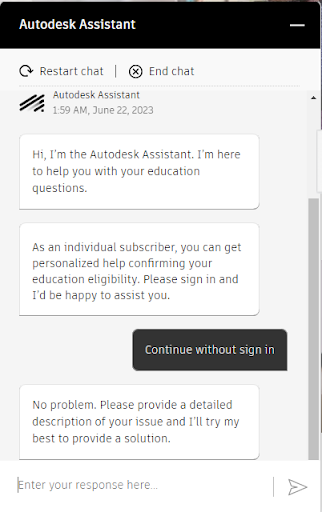

Autodesk has designed a virtual agent named AVA (Autodesk Virtual Agent) to answer customer queries, provide technical support questions, and offer information about the wide range of Autodesk’s products.
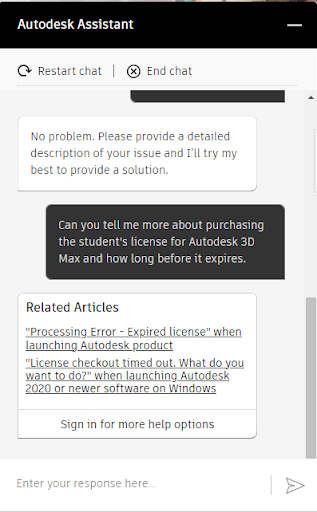

AVA can also help customers find relevant documentation, tutorials, or guides related to their queries. For example, once asked about the student’s license for Autodesk 3Ds Max, it provides relevant links from the Knowledge Base. This can assist users in learning more about the software without spending endless hours looking for the right information or trying to speak to a support agent.
Empowering teams knowledge
Companies can also use ChatGPT to enable teams to contribute to and distribute knowledge seamlessly throughout the organization. Knowledge-sharing should be free of unnecessary hurdles, and AI technology can serve as a handy tool to eliminate this.
With the necessary customization and integration into standard platforms, ChatGPT can give team members easy access to information where it only takes a few conversations to discover answers to specific queries. Let’s take a look at an example.
Salesforce’s Einstein Bot can easily be integrated into Salesforce’s CRM so that teams can quickly access relevant information to support customer interactions and internal knowledge sharing. Einstein bot supports multiple communication channels, including messaging platforms like SMS, WhatsApp, apps, and websites.
Einstein has some interesting use cases for empowering team knowledge. Teams can use it to:
- Search for records and provide updates on the records
- template document collection,
- Qualify leads by asking relevant questions and then routing the qualified leads to the sales team
- collect feedback, and analyze the data for insights.


Improving Communication Skills and User Experience
The right communication skills among team members make disseminating crucial information faster and easier. One way to ensure this is to encourage collaboration, where team members are comfortable sharing their expertise and asking questions from others for clarification or problem-solving.
A handy collaboration tool is ChatGPT, which is excellent for improving communication skills and team collaboration. This tool can answer queries, assist with sharing knowledge, and provide valuable recommendations. With this, team members can share ideas to boost learning and development.
Slack’s integration with ChatGPT, named Slack GPT, makes it an even better knowledge-sharing tool. Integrating AI seamlessly into Slack channels enhances communication by bringing employees up-to-date with missed conversations. Customers can also easily access past information, perform quick searches, and get answers to questions within the platform.
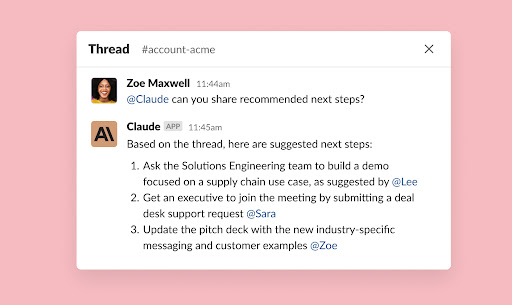

Generating AI-Powered Content to Enhance Customer Satisfaction
Ultimately, team members within the organization are just some of the beneficiaries of the application of ChatGPT in knowledge management.
AI-powered content can also enhance customer satisfaction, which boosts retention. Happy customers can quickly become long-term users of your products or services as they understand that your company has what it takes to provide what they need and respond to their queries promptly.
Duolingo Max incorporates a ChatGPT-based feature to optimize their customer’s learning experiences. Learners can now access new features like ‘explain my answer,’ which retrieves information from their knowledge base to offer learners a chance to let them know why they got an answer wrong (or right) and provides further clarifications.
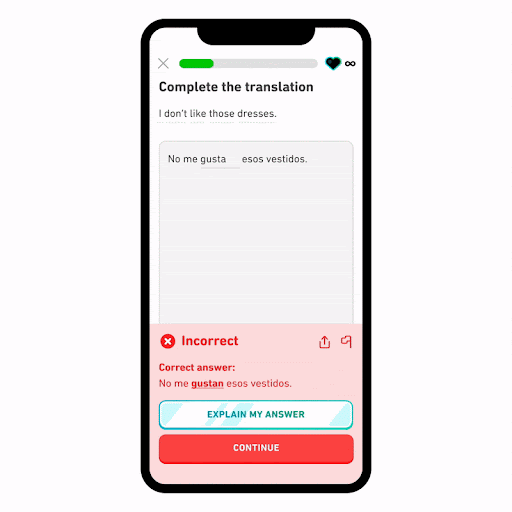

Personalize learning experience for every stage of the customer journey
The customer journey is in different stages, from onboarding to retention. Understanding every step of this journey helps to identify high-friction areas and create personalized content to tackle any issues.
An AI-powered solution like ChatGPT will be crucial in identifying gaps in your current knowledge base and creating a personalized learning path that aids the learning process. Since this will be tailored to each stage of the customer journey, customers can easily learn at their own pace, which is perfect for encouraging a positive customer experience.
Microsoft incorporates AI to create a personalized learning experience in its Azure cognitive search knowledge base. New users can browse between sections or use the search bar to find relevant information faster.


Provide multilingual support to customers.
What if you could use AI to expand your customer base by eliminating the language barrier? This is possible through ChatGPT technology. With ChatGPT, you can create a multilingual knowledge base for your customers, making it easy to improve localization efforts and translate the content language according to location.
Multilingual support encourages inclusivity for diverse cultures. This makes it easy to effectively reach and cater to a diverse language-speaking audience in different parts of the world. For businesses, this opens up more room for expansion and significantly increases your target market with a new customer base.
A good example of a company harnessing the multilingual knowledge base is Document360. Our localized knowledge base management system was designed to translate functionalities, articles, and controls with AI-powered machine translation into the original language of the target audience.
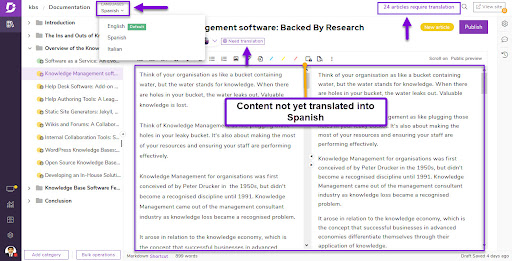

Employee training and customer onboarding
ChatGPT can help deliver training content and provide on-demand support for employees. When properly integrated, this technology can serve as a virtual trainer with step-by-step instructions in different formats, including video, audio, and text. Employees can access training materials whenever they want and learn at their own pace. This personalized experience can be extended to the customer onboarding process as well.
ChatGPT can provide proactive guidance during the product onboarding process. It’s great for organizing topics clearly into sections and troubleshooting without requiring customers to contact support teams. This AI technology can be trained to effectively suggest personalized recommendations that help customers reach their desired outcomes.
Retrieve useful information from unorganized data
ChatGPT can retrieve useful information from unorganized data, as this tool can analyze data sources. You can train this AI technology to identify unstructured data, determine the information you need from this data, and provide real-time access to this useful information when needed.
With this, employees and customers can learn more about your brand and products by leveraging the power of ChatGPT for information retrieval.
Conclusion
ChatGPT is a unique and valuable resource for organizations that would love to improve employee efficiency and boost customer experience by managing knowledge better. With this AI technology, you can effectively reduce the time it takes to solve critical issues and stay in tune with evolving customer needs in your industry.
The knowledge management process needs the right tools to be successful. With a seamless collaboration tool and user-friendly interface, you can better share knowledge with employees and customers. Ready to leverage ChatGPT for knowledge management? Request a demo on Document360 to get started today.
An intuitive knowledge base software to easily add your content and integrate it with any application. Give Document360 a try!
GET STARTED



